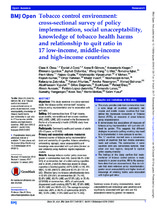| dc.contributor.author | Chow, Clara K. | |
| dc.contributor.author | Corsi, Daniel J. | |
| dc.contributor.author | Gilmore, Anna B. | |
| dc.contributor.author | Kruger, Annamarie | |
| dc.contributor.author | Igumbor, Ehimario | |
| dc.date.accessioned | 2018-10-19T07:05:19Z | |
| dc.date.available | 2018-10-19T07:05:19Z | |
| dc.date.issued | 2017 | |
| dc.identifier.citation | Chow, C.K. et al. (2017). Tobacco control environment: cross-sectional survey of policy implementation, social unacceptability, knowledge of tobacco health harms and relationship to quit ratio in 17 low-income, middleincome and high-income countries. BMJ Open, 7: e013817. | en_US |
| dc.identifier.issn | 2044-6055 | |
| dc.identifier.uri | http://dx.doi.org/10.1136/ bmjopen-2016-013817 | |
| dc.identifier.uri | http://hdl.handle.net/10566/4140 | |
| dc.description.abstract | OBJECTIVES: This study examines in a cross-sectional
study ‘the tobacco control environment’ including
tobacco policy implementation and its association with
quit ratio.
SETTING: 545 communities from 17 high-income,
upper-middle, low-middle and low-income countries
(HIC, UMIC, LMIC, LIC) involved in the Environmental
Profile of a Community’s Health (EPOCH) study from
2009 to 2014.
PARTICIPANTS: Community audits and surveys of adults
(35–70 years, n=12 953).
PRIMARY AND SECONDARY OUTCOME MEASURES:
Summary scores of tobacco policy implementation
(cost and availability of cigarettes, tobacco advertising,
antismoking signage), social unacceptability and
knowledge were associated with quit ratios (former vs
ever smokers) using multilevel logistic regression
models.
RESULTS: Average tobacco control policy score was
greater in communities from HIC. Overall 56.1% (306/
545) of communities had >2 outlets selling cigarettes
and in 28.6% (154/539) there was access to cheap
cigarettes (<5cents/cigarette) (3.2% (3/93) in HIC, 0%
UMIC, 52.6% (90/171) LMIC and 40.4% (61/151) in
LIC). Effective bans (no tobacco advertisements) were
in 63.0% (341/541) of communities (81.7% HIC,
52.8% UMIC, 65.1% LMIC and 57.6% LIC). In 70.4%
(379/538) of communities, >80% of participants
disapproved youth smoking (95.7% HIC, 57.6% UMIC,
76.3% LMIC and 58.9% LIC). The average knowledge
score was >80% in 48.4% of communities (94.6%
HIC, 53.6% UMIC, 31.8% LMIC and 35.1% LIC).
Summary scores of policy implementation, social
unacceptability and knowledge were positively and
significantly associated with quit ratio and the
associations varied by gender, for example,communities in the highest quintile of the combined scores had 5.0
times the quit ratio in men (Odds ratio (OR) 5 0, 95% CI 3.4 to 7.4)
and 4.1 times the quit ratio in women (OR 4.1, 95% CI 2.4 to 7.1).
CONCLUSIONS: This study suggests that more focus is needed on
ensuring the tobacco control policy is actually implemented,
particularly in LMICs. The gender-related differences in associations
of policy, social unacceptability and knowledge suggest that different
strategies to promoting quitting may need to be implemented in men
compared to women. | en_US |
| dc.language.iso | en | en_US |
| dc.publisher | BMJ Publishing Group | en_US |
| dc.rights | This is an Open Access article distributed in accordance with
the Creative Commons Attribution Non Commercial (CC BY-NC 4.0) license,
which permits others to distribute, remix, adapt, build upon this work noncommercially,
and license their derivative works on different terms, provided
the original work is properly cited and the use is non-commercial. See: http://
creativecommons.org/licenses/by-nc/4.0/ | |
| dc.subject | The tobacco control environment | en_US |
| dc.subject | Tobacco policy implementation | en_US |
| dc.subject | Quit ratio | en_US |
| dc.title | Tobacco control environment: cross-sectional survey of policy implementation, social unacceptability, knowledge of tobacco health harms and relationship to quit ratio in 17 low-income, middle-income and high-income countries | en_US |
| dc.type | Article | en_US |
| dc.privacy.showsubmitter | FALSE | |
| dc.status.ispeerreviewed | TRUE | |
| dc.description.accreditation | ISI | |

